It is often not possible or practical to return many disturbed sites to their original biotic and abiotic features; restoration goals, instead, tend to focus on the maintenance of ecosystem processes and the provision of ecosystem services. Knowing your restoration goals will help you develop an effective restoration design and make species choice much easier. Goal setting can also aid in selecting indicators for evaluating restoration success.
Biodiversity Enhancement
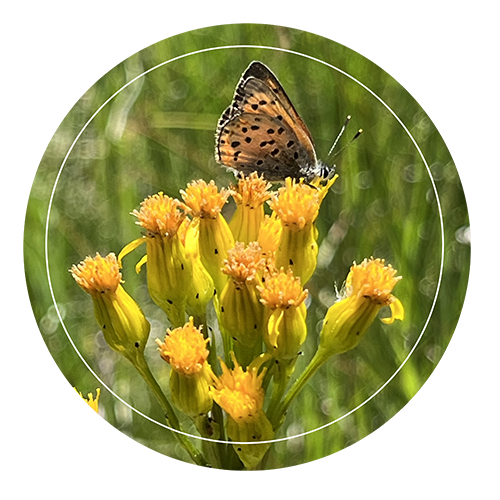
California boasts exceptionally high biodiversity, encompassing both a rich variety of species and a diversity of ecosystems. Increasing plant diversity is often an explicit goal of restoration, and biodiversity is well known to enhance a variety of ecosystem services [1], such as the presence of wildlife habitat, the encouragement of pollinator visitation, and the reduction of invasion by non native species. Enhancing biodiversity can be facilitated across a variety of organizational levels. For example, functional group (grasses, shrubs, and forbs) diversity can be as important as species-level diversity [2]. Moreover, providing diversity in phenology (when plants green up and flower) and form (planting species of different sizes and shapes), provides better wildlife habitat [3] and can facilitate greater productivity overall [4]. Generally, differences in vegetation type and look cultivate different animal types by providing a greater number of resources. For example, increased structural diversity in grasslands contributes to greater bird diversity [5]. Managers should keep in mind that more biodiverse seed mixes are almost always better for restoration outcomes. For example, in California rangelands, greater plant diversity in restored sites could increase community stability in the face of rainfall variability [6]. However, there are instances where this approach does not buffer against non-ideal weather conditions [7]. In many of California's ecosystems, perennial plant establishment is the primary focus of restoration efforts, but practitioners should incorporate other species (e.g., annual forbs) when possible to avoid the homogenization of biodiversity that may occur during restoration [8].
Resources
Biodiversity Enhancement References
- Benayas, J. M. R., Newton, A. C., Diaz, A., & Bullock, J. M. (2009). Enhancement of biodiversity and ecosystem services by ecological restoration: a meta-analysis. Science, 325(5944), 1121-1124. https://doi.org/10.1126/science.1172460
- Cadotte, M. W., Carscadden, K., & Mirotchnick, N. (2011). Beyond species: functional diversity and the maintenance of ecological processes and services. Journal of applied ecology, 48(5), 1079-1087. https://doi.org/10.1111/j.1365-2664.2011.02048.x
- Havens, K., & Vitt, P. (2016). The importance of phenological diversity in seed mixes for pollinator restoration. Natural Areas Journal, 36(4), 531-537. https://doi.org/10.3375/043.036.0418
- Fitzgerald, M., Gonzalez, K., Funk, J. L., Whitcraft, C. R., & Allen, B. J. (2021). Recovering ecosystem functions in a restored salt marsh by leveraging positive effects of biodiversity. Ecosphere, 12(8), e03664. https://doi.org/10.1002/ecs2.3664
- Hovick, T. J., Elmore, R. D., & Fuhlendorf, S. D. (2014). Structural heterogeneity increases diversity of non‐breeding grassland birds. Ecosphere, 5(5), 1-13. https://doi.org/10.1890/ES14-00062.1
- Hallett, L. M., Stein, C., & Suding, K. N. (2017). Functional diversity increases ecological stability in a grazed grassland. Oecologia, 183, 831-840. https://doi.org/10.1007/s00442-016-3802-3
- Groves, A. M., & Brudvig, L. A. (2019). Interannual variation in precipitation and other planting conditions impacts seedling establishment in sown plant communities. Restoration Ecology, 27(1), 128-137. https://doi.org/10.1111/rec.12708
- Lesage, J. C., Howard, E. A., & Holl, K. D. (2018). Homogenizing biodiversity in restoration: the “perennialization” of California prairies. Restoration Ecology, 26(6), 1061-1065. https://doi.org/10.1111/rec.12887
Erosion Control
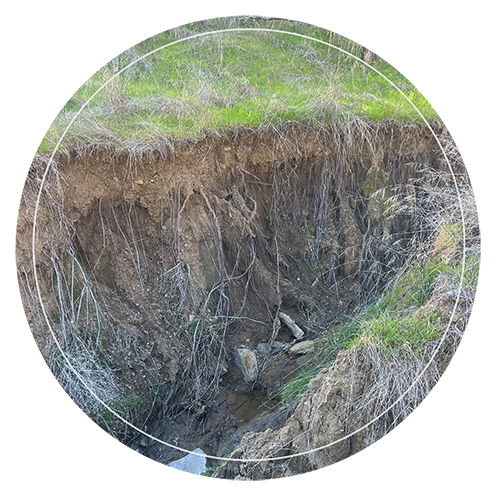
The USDA has noted that soil is eroding at a rate of approximately 5 tons per year, although in many cases, sites can be losing closer to 100 tons per acre! Surface erosion can occur on slopes as flat at two percent [1] and is most likely to occur on medium-textured soils [2]. Erosion is most likely to occur on soils that experience reduced ground cover from fire, overgrazing and other disturbances. Restoration projects are often implemented on disturbed sites that are prone to soil erosion due to a lack of plant cover and alteration of soil structure. In many instances, revegetation is undertaken specifically to prevent erosion control, such as following wildfires or mechanical disturbance of a site.
Although seeding after disturbance can be an effective approach for minimizing subsequent erosion, the success of this approach is strongly dependent on initial cover of seeded species [3]. In addition to revegetation, surface mulches, biodegradable matting (like coconut fiber) and other man-made structures (such as wattles) that modify runoff flows can be effective in protecting soil from erosion, however, the reestablishment of permanent plant cover is generally the most effective approach for maintaining erosion control [4]. Fast growing species that develop large root systems can be particularly useful for arresting soil loss. There are commercial seed mixes available specifically for erosion control in California which are designed to revegetate sites without the need for irrigation (though success will depend on rainfall). Using jute netting and hydroseeding can be effective strategies for erosion prone hillsides [5]. However, hydroseeding such fast-growing species (or introducing them through other means) could have unintended consequences for native plant reestablishment. For example, in post-fire chaparral stands, hydroseeding with native grasses reduced the risk of erosion, but this treatment also hampered the establishment and growth of native shrub species [6].
Resources
Erosion References
- Lynch, K. (1971). Site Planning, 2nd ed. MIT Press, Cambridge, MA. https://mitpress.mit.edu/9780262120500/site-planning/
- Meyer, L. D., & Monke, E. J. (1965). Mechanics of soil erosion by rainfall and overland flow. Transactions of the ASAE 8(4), 572–577. https://doi.org/10.13031/2013.40586
- Pyke, D. A., Wirth, T. A., & Beyers, J. L. (2013). Does seeding after wildfires in rangelands reduce erosion or invasive species? Restoration Ecology 21(4), 415–421. https://doi.org/10.1111/rec.12021
- Brooks, M. A. (1993). Evaluation of roadside revegetation in Central Arizona. The University of Arizona. https://repository.arizona.edu/handle/10150/186330
- Tamura, N., Lulow, M. E., Halsch, C. A., Major, M. R., Balazs, K. R., Austin, P., Huxman, T., & Kimball, S. (2017). Effectiveness of seed sowing techniques for sloped restoration sites. Restoration Ecology 25(6), 942–952. https://doi.org/10.1111/rec.12515
- Vourlitis, G. L., Griganavicius, J., Gordon, N., Bloomer, K., Grant, T., & Hentz, C. (2017). Hydroseeding increases ecosystem nitrogen retention but inhibits natural vegetation regeneration after two years of chaparral post-fire recovery. Ecological Engineering 102, 46–54. https://doi.org/10.1016/j.ecoleng.2017.01.041
Fire Resistance
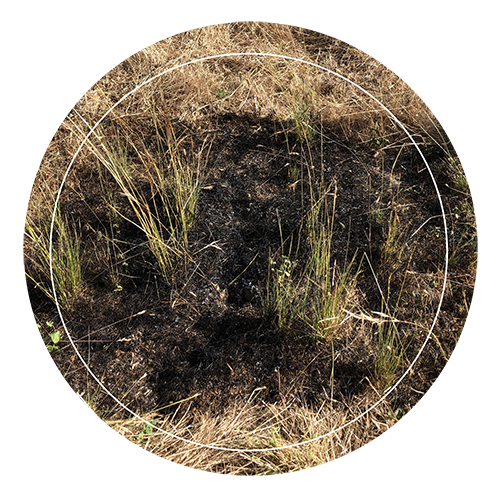
Fire is an important ecological process in many of California’s ecosystems, but the frequency and severity of wildfires in the State is increasing due to climate change, nonnative plant invasion, and decades of fire suppression leading to high fuel loads [1]. Catastrophic wildfires can have devastating effects on native plants and animals and water resources, as well as human life and property. Many plant species in California possess unique adaptations for surviving wildfires, but they may not be able to persist when historic fire regimes are altered.
Several land management approaches can be used to reduce wildfire risk. Controlling nonnative plant species, especially invasive annual grasses which easily catch and spread fire, can minimize fire risk [2]. Unless these invasives are replaced by natives, treatment will need to occur regularly (at least annually) to prevent the buildup of “flashy fuels”. In some forested ecosystems, woody fuel loads may need to be reduced through thinning or prescribed fire in order to prevent more catastrophic fires from occurring when the site experiences wildfire [3].
For some restoration projects in fire-prone areas, it is desirable to establish fire-resistant vegetation. Choosing native plant species that contain low levels of volatile oils or resins, maintain high moisture content with limited watering, and produce little dead or fine material can provide increased fire resistance in vulnerable areas [4]. Low irrigation of native shrubs (e.g., near homes or structures) can reduce fire hazards while maintaining the other benefits of native vegetation [5].
Resources
Fire Resistance References
- Steel, Z. L., Safford, H. D., & Viers, J. H. (2015). The fire frequency‐severity relationship and the legacy of fire suppression in California forests. Ecosphere, 6(1), 1-23. https://doi.org/10.1890/ES14-00224.1
- Lambert, A. M., D’antonio, C. M., & Dudley, T. L. (2010). Invasive species and fire in California ecosystems. Fremontia, 38(2), 29-36. PDF
- Agee, J. K., & Skinner, C. N. (2005). Basic principles of forest fuel reduction treatments. Forest ecology and management, 211(1-2), 83-96. https://doi.org/10.1016/j.foreco.2005.01.034
- Drill, S. L. (2010). Sustainable and Fire-Safe Landscapes: Achieving Wildfire Resistance and Environmental Health in the Wildland-Urban Interface. Fremontia, 37. PDF
- Keeley, J. E., Rubin, G., Brennan, T., & Piffard, B. (2020). Protecting the wildland-urban interface in California: greenbelts vs thinning for wildfire threats to homes. Bulletin, Southern California Academy of Sciences, 119(1), 35-47. https://doi.org/10.3160/0038-3872-119.1.35
Forage Production
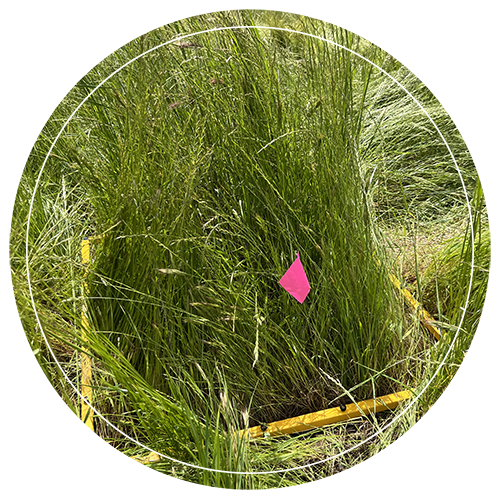
Rangelands cover millions of acres in California, encompassing a significant portion of the state’s diverse landscapes, including grasslands, shrublands, and woodlands. These rangelands are crucial for supporting biodiversity, providing habitat for wildlife, and sustaining agricultural practices, particularly livestock grazing, which is a key component of California’s economy [1]. While overgrazing can disturb native ecosystems, proper livestock management is not incompatible with ecological restoration and in some cases can be an important tool for conserving biodiversity and ecosystem functioning [2].
Although introduced species are often favored by livestock, native species can provide high forage value for a variety of grazing animals [3]. In specific circumstances, grazing may accelerate the recovery of poor condition rangelands [4]. Grazing, prescribed fire, and target mowing have all been shown to promote the recovery of desirable native perennial grasses [5,6]. The timing and intensity of grazing is a key determinant of outcomes for native vegetation. For example, strategic rest-rotational grazing can be used to restore rangelands to native bunchgrasses, improve water and carbon storage in the soil, and increase biodiversity while simultaneously sustaining forage potential [7]. Seeding of native plant species has the potential to sustain or enhance forage production [8] as well as limit the invasion of undesirable (i.e., unpalatable) nonnative plant species [9]. While bunchgrasses are often the target of grassland restoration, not all sites may be able to support these species. In fact, the majority of rangelands in California are annual systems [10]. In some sites where native vegetation consists of predominantly annual forbs, certain grazing practices could favor invasive annual grasses over native forbs [11].
Resources
Forage Production References
- Huntsinger, L., & Oviedo, J. L. (2014). Ecosystem services are social–ecological services in a traditional pastoral system: The case of California’s Mediterranean rangelands. Ecology and Society, 19(1). https://www.jstor.org/stable/26269476
- Barry, S., & Huntsinger, L. (2021). Rangeland land-sharing, livestock grazing’s role in the conservation of imperiled species. Sustainability, 13(8), 4466. PDF
- Martin, S. C., & Severson, K. E. (1988). Vegetation response to the Santa Rita grazing system. Rangeland Ecology & Management/Journal of Range Management Archives, 41(4), 291-295. PDF
- Forero, L., Davey, J., Barry, S., Bartolome, J., & Larson, S. (2020). Field Guide to Common California Rangeland and Pasture Plants. UCANR Publications. PDF
- Menke, J. W. (1992). Grazing and fire management for native perennial grass restoration in California grasslands. Fremontia, 20(2), 22-25. PDF
- Valliere, J. M., Balch, S., Bell, C., Contreras, C., & Hilbig, B. E. (2019). Repeated mowing to restore remnant native grasslands invaded by nonnative annual grasses: Upsides and downsides above and below ground. Restoration Ecology, 27(2), 261-268. https://doi.org/10.1111/rec.12873
- Henneman, C., Seavy, N. E., & Gardali, T. (2014). Restoring native perennial grasses by changing grazing practices in central coastal California. Ecological Restoration, 32(4), 352-354. https://www.jstor.org/stable/43441681
- Briske, D. D. (2011). Conservation benefits of rangeland practices: assessment, recommendations, and knowledge gaps. https://doi.org/10.2111/RANGELANDS-D-12-00040.1
- Eastburn, D. J., et al. "Seeding plants for long-term multiple ecosystem service goals." Journal of Environmental Management 211 (2018): 191-197. https://doi.org/10.1016/j.jenvman.2018.01.061
- Liu, H., Jin, Y., Roche, L. M., T O’Geen, A., & Dahlgren, R. A. (2021). Understanding spatial variability of forage production in California grasslands: delineating climate, topography and soil controls. Environmental Research Letters, 16(1), 014043. https://doi.org/10.1088/1748-9326/abc64d
- HilleRisLambers, J., Yelenik, S. G., Colman, B. P., & Levine, J. M. (2010). California annual grass invaders: the drivers or passengers of change?. Journal of Ecology, 98(5), 1147-1156. https://doi.org/10.1111/j.1365-2745.2010.01706.x
Pollinator Habitat
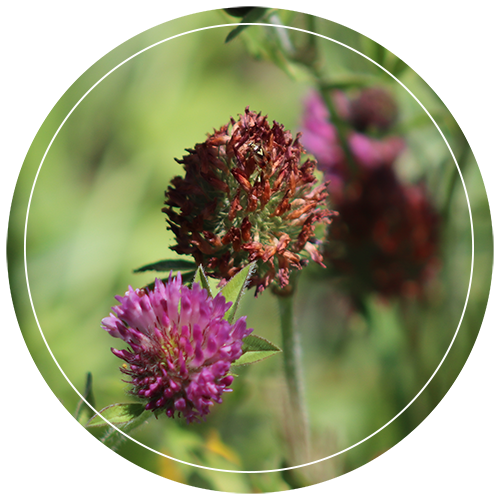
Declines in pollinator populations are a global concern, and restoring native plant communities is a key strategy for reversing this trend [1]. Although revegetation efforts for pollinators can be one of the most expensive types of restoration goals [2], pollinator habitat enhancement can indirectly benefit lots of other ecosystem services [3]. For example, creating hedgerows of native vegetation along crop field edges can substantially enhance the number and biodiversity of pollinators in agricultural landscapes [4]. Using pollinator seed mixes for restoration can also boost pollination visits of rare plant species that are targets for conservation [5].
Generally, pollinators require plants that flower at different times during the growing season, which enhances resource availability [6]. Strategic placement of restoration throughout a landscape can also enhance pollinator habitat. For example, connectivity across the landscape is important for the movement of many pollinators, including Monarchs. Restoring forbs (where appropriate) to riparian corridors, urban greenspaces, or hedgerows can enhance connectivity and promote healthy pollinator communities [7]. Additionally, planting in clumps, rather than a regular, spaced pattern across a landscape can enhance pollinator services [8].
Resources
- A Tool for Selecting Plants When Restoring Habitat for Pollinators
- Xerces Society | Pollinator Conservation Resources California
- CARCD | Pollinator and Wildlife Habitats
- Calscape | Pollinator Friendly Plants
- CNPS | Bee-friendly Gardening
- Pollinator Partnership | Planting Guides
- UC Master Gardeners | Natives for a Hedge Row
Pollinator Habitat References
- Menz, M. H., Phillips, R. D., Winfree, R., Kremen, C., Aizen, M. A., Johnson, S. D., & Dixon, K. W. (2011). Reconnecting plants and pollinators: challenges in the restoration of pollination mutualisms. Trends in plant science, 16(1), 4-12. https://doi.org/10.1016/j.tplants.2010.09.006
- Miller, James R., and Richard J. Hobbs. "Habitat restoration—Do we know what we’re doing?." Restoration Ecology 15.3 (2007): 382-390. https://doi.org/10.1111/j.1526-100X.2007.00234.x
- Christmann, S. (2019). Do we realize the full impact of pollinator loss on other ecosystem services and the challenges for any restoration in terrestrial areas? Restoration Ecology, 27(4), 720-725. https://doi.org/10.1111/rec.12950
- Morandin, L. A., & Kremen, C. (2013). Hedgerow restoration promotes pollinator populations and exports native bees to adjacent fields. Ecological Applications, 23(4), 829-839. https://doi.org/10.1890/12-1051.1
- Galea, M. B., Wojcik, V., & Dunn, C. (2016). Using pollinator seed mixes in landscape restoration boosts bee visitation and reproduction in the rare local endemic Santa Susana tarweed, Deinandra minthornii. Natural Areas Journal, 36(4), 512-522. https://doi.org/10.3375/043.036.0416
- Havens, K., & Vitt, P. (2016). The importance of phenological diversity in seed mixes for pollinator restoration. Natural Areas Journal, 36(4), 531-537. https://doi.org/10.3375/043.036.0418
- Ponisio, L. C., de Valpine, P., M’Gonigle, L. K., & Kremen, C. (2019). Proximity of restored hedgerows interacts with local floral diversity and species' traits to shape long‐term pollinator metacommunity dynamics. Ecology Letters, 22(7), 1048-1060. https://doi.org/10.1111/ele.13257
- McCallum, K. P., Breed, M. F., Paton, D. C., & Lowe, A. J. (2019). Clumped planting arrangements improve seed production in a revegetated eucalypt woodland. Restoration Ecology, 27(3), 638-646. https://doi.org/10.1111/rec.12905
Post-fire Restoration
Post-fire restoration is a critical priority in California, where increasingly frequent and severe wildfires can dramatically alter landscapes [1]. In some areas, natural regeneration and passive restoration may be sufficient, especially where native vegetation and seedbanks remain intact. However, in heavily burned or degraded areas, active restoration is often necessary to stabilize soils, reduce erosion, and prevent the spread of invasive species. Even in areas where native species remain above ground or in the soil seedbank, invasive species, drought, and nitrogen deposition may hinder post-fire recovery [2]. Without intervention, many of these landscapes are at risk of converting to non-native annual grasslands, which not only reduce biodiversity but also increase future fire risk due to their flammability. Active restoration efforts help support long-term ecosystem resilience, protect water quality, and preserve native plant and animal communities.
Restoration after fire is not only costly [3] and time-consuming, but also requires careful planning and sustained effort to be successful. When approaching post-fire restoration in California, it’s important to start with site assessment to determine whether passive or active restoration is needed [4]. In areas requiring intervention, reseeding or planting native species adapted to local conditions can help jumpstart recovery. Seeding native annuals along with perennials can improve restoration success, reduce erosion, and better exclude nonnative weeds [5]. Mulching and installing erosion control structures may also be necessary on steep or bare slopes. Restoration practitioners should aim to act quickly after fire events, before invasive species establish dominance, and continue monitoring, weed control, and adaptive management for several years. Collaborating with local resource agencies and utilizing native seed and plant materials from regional sources will help ensure restoration efforts are ecologically appropriate and effective.
Resources
- Theodore Payne Foundation | Post-Fire Regeneration
- US Forest Service | Post-fire Restoration Framework for National Forests in California
- CNPS | Fire Recovery Guide
- California Fire Science Consortium | Fire Research
- Sonoma RCD | Fire Mitigation and Post-fire Recovery
- National Forest Foundation | Important Facts You Should Know About Post-Fire Restoration
- Identifying Priorities for Post-fire Restoration in California Chaparral
Post-fire Restoration References
- Westerling, Anthony L., et al. “Climate change and growth scenarios for California wildfire.” Climatic Change 109 (2011): 445–463. https://doi.org/10.1007/s10584-011-0329-9
- Valliere, J. M., Irvine, I. C., & Allen, E. B. (2024). Nitrogen deposition suppresses ephemeral post-fire plant diversity. Global Change Biology 30(1): e17117. https://doi.org/10.1111/gcb.17117
- Underwood, E. C., Hollander, A. D., Molinari, N. A., Larios, L., & Safford, H. D. (2022). Identifying priorities for post-fire restoration in California chaparral shrublands. Restoration Ecology 30(3): e13513. https://doi.org/10.1111/rec.13513
- Herron, C. M., Jonas, J. L., Meiman, P. J., & Paschke, M. W. (2013). Using native annual plants to restore post-fire habitats in western North America. International Journal of Wildland Fire 22(6): 815–821. https://doi.org/10.1071/WF11179
Soil Rehabilitation
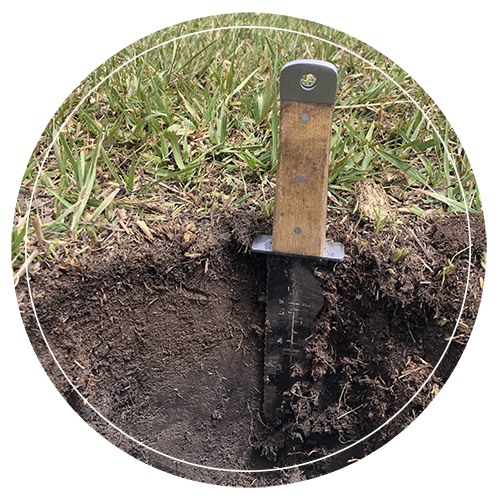
When working with severely degraded soil (e.g. mine tailings, contaminated sites, or oil and gas pads), plants can be used for phytoremediation where seeded or planted species can stabilize or uptake soil contaminants. Establishing vegetation on severely degraded sites will also result in increased soil organic matter and nutrient content, however, stress tolerant plants must be selected to survive such harsh conditions as saline or acidic soils. Managers should be strategic in their restoration approach and use a variety of techniques when possible. For example, liquid gypsum can be used to remove salts and soften hard, compacted soils [1], while compost [2] and biochar [3] application may reduce toxicity of contaminated soils. Outcomes are likely to be context dependent. For example, at an abandoned golf course in California, the addition of gypsum was shown to reduce soil salinity, while biochar and fertilization increased native plant growth, but fertilization alone increased weed growth [4]. Soil biota play an important role in plant stress tolerance, and soil inoculations may be an important tool for rehabilitating and restoring degraded soils [5]. The addition or cultivation of native biological soil crusts (thin layer of cyanobacteria-lichen-bryophyte microbial communities on the soil surface) can also enhance plant community establishment as these crusts are critically important to soil structure and function in drylands [6]. Finally, planting plugs, rather than seeding, can be an effective way to inoculate soil with beneficial organisms that are living in the container soil [7]. Native soil biota are likely to be more effective in this regard than commercially available products [8].
Resources
- USGS | Field Guide to Biological Soil Crusts of the Western US
- EPA | The Use of Soil Amendments for Remediation, Revitalization, and Reuse
- EPA | Phytoremediation Resource Guide
- NRCS California Soils Program
- Rehabilitation of Disturbed Lands in California
- Phytoremediation Database
- National Association of Abandoned Mine Land Programs
Soil Rehabilitation References
- Hanay, A., Büyüksönmez, F., Kiziloglu, F. M., & Canbolat, M. Y. (2004). Reclamation of saline-sodic soils with gypsum and MSW compost. Compost science & utilization, 12(2), 175-179. https://doi.org/10.1080/1065657X.2004.10702177
- Kästner, M., & Miltner, A. (2016). Application of compost for effective bioremediation of organic contaminants and pollutants in soil. Applied microbiology and biotechnology, 100, 3433-3449. https://doi.org/10.1007/s00253-016-7378-y
- Beesley, L., Moreno-Jiménez, E., Gomez-Eyles, J. L., Harris, E., Robinson, B., & Sizmur, T. (2011). A review of biochars’ potential role in the remediation, revegetation and restoration of contaminated soils. Environmental pollution, 159(12), 3269-3282. https://doi.org/10.1016/j.envpol.2011.07.023
- Nolan, M., Bilodeau, C., & Stratton, L. (2020). Trade-offs in Restoration: Using Soil Amendments to Address Restoration Challenges for Plants. Ecological Restoration, 38(1), 32-41. https://doi.org/10.3368/er.38.1.32
- Valliere, J. M., Wong, W. S., Nevill, P. G., Zhong, H., & Dixon, K. W. (2020). Preparing for the worst: Utilizing stress‐tolerant soil microbial communities to aid ecological restoration in the Anthropocene. Ecological Solutions and Evidence, 1(2), e12027. https://doi.org/10.1002/2688-8319.12027
- Chiquoine, L. P., Abella, S. R., & Bowker, M. A. (2016). Rapidly restoring biological soil crusts and ecosystem functions in a severely disturbed desert ecosystem. Ecological Applications, 26(4), 1260-1272. https://doi.org/10.1002/15-0973
- Emam, T. (2016). Local soil, but not commercial AMF inoculum, increases native and non‐native grass growth at a mine restoration site. Restoration Ecology, 24(1), 35-44. https://doi.org/10.1111/rec.12287
- Wong, W. S., Ruscalleda-Alvarez, J., Yong, J. W., Stevens, J. C., Valliere, J. M., & Veneklaas, E. J. (2024). Limited efficacy of a commercial microbial inoculant for improving growth and physiological performance of native plant species. Conservation Physiology, 12(1). https://doi.org/10.1093/conphys/coae037
Weed Exclusion
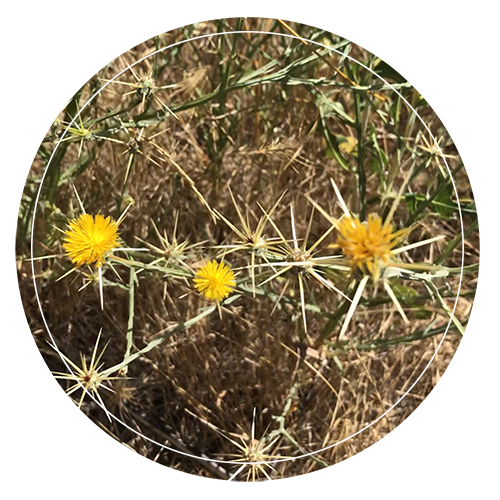
Weed control is a crucial aspect of ecological restoration, but restoring native plant communities can also serve as a proactive measure to prevent weed establishment, a strategy sometimes called "competitive planting." Restoration practitioners can choose native species that are strong competitors against invasive weeds, enhancing the ecosystem’s resistance to invasion [1]. Mature plants are more likely to resist invasion than seedlings [2]. Incorporating a diverse mix of functional groups and lifeforms, such as annual forbs and perennial species, can further strengthen invasion resistance [3]. Additionally, selecting native species with phenologies similar to invasive weeds can be particularly effective. For instance, planting native summer annuals [4] or bunchgrasses [5] that are active later in the growing season can reduce the risk of invasion by yellow starthistle, which also grows and flowers later in summer. If there are known invasive species in adjacent sites, early detection and removal of weedy species may be necessary to keep the restoration site free from invasive species. Care should always be taken to keep construction/restoration equipment and any other sources of weed seed clean of soil and plant material when moving between sites so that the weeds are not spread from one disturbed site to another.
Weed Identification
Weed References
- Thomsen, M.A. and D'Antonio, C.M. (2007), Mechanisms of resistance to invasion in a California grassland: the roles of competitor identity, resource availability, and environmental gradients. Oikos, 116: 17-30. https://doi.org/10.1111/j.2006.0030-1299.14929.x
- Bell, M. D., Lulow, M. E., Balazs, K. R., Huxman, K. A., McCollum, J. R., Huxman, T. E., & Kimball, S. (2019). Restoring a Mediterranean‐climate shrub community with perennial species reduces future invasion. Restoration Ecology, 27(2), 298-307. https://doi.org/10.1111/rec.12851
- Oakley, C.A. and Knox, J.S. (2013), Plant species richness increases resistance to invasion by non-resident plant species during grassland restoration. Appl Veg Sci, 16: 21-28. https://doi.org/10.1111/j.1654-109X.2012.01202.x
- Hulvey, K.B. and Teller, B.J. (2018), Site conditions determine a key native plant's contribution to invasion resistance in grasslands. Ecology, 99: 1257-1264. https://doi.org/10.1002/ecy.2227
- Young, S.L., Barney, J.N., Kyser, G.B., Jones, T.S. and DiTomaso, J.M. (2009), Functionally Similar Species Confer Greater Resistance to Invasion: Implications for Grassland Restoration. Restoration Ecology, 17: 884-892. https://doi.org/10.1111/j.1526-100X.2008.00448.x
Wildlife Habitat
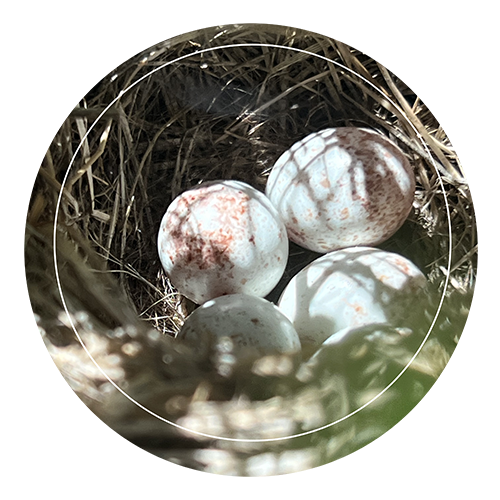
There are many reasons to restore wildlife habitat. For example, game species may be of interest, or landowners may be avid birders. Landowners might also need to adhere to requirements made by an agency such as the US Fish and Wildlife to include vegetation at a restoration site that supports existing wildlife in general, or to provide specific habitat structure or food sources for a threatened or endangered animal whose habitat may have been harmed. General wildlife habitat generally requires high heterogeneity in plant type and structure [1] while particular species of interest can be targeted with a strategic seed mix or plant palette. For example, seed eating desert rodents tend to prefer large-seeded winter annuals for food [2] while ants tend to specialize on smaller seeded species [3].
Resources
- Audubon | Plants for Birds
- Basic Steps for Habitat Gardening with California Native Plants
- CARCD | Pollinator and Wildlife Habitat
- CalFish | Restoration Projects
- Calscape | Support Wildlife
- CNPS | Habitat Gardening
- Coastal Restoration Toolkit for Wildlife & Fish Habitat
- NPS | Gardening for Wildlife with Native Plants
- WCB | Habitat Enhancement and Restoration Program
Case studies
Wildlife Habitat References
- Larkin, D. J., Bruland, G. L., & Zedler, J. B. (2016). Heterogeneity theory and ecological restoration. Foundations of restoration ecology, 271-300. https://doi.org/10.5822/978-1-61091-698-1_10
- Brown, J. H. (1986). Experimental, community ecology: the desert granivore system. Community ecology:, 41-62.
- Davidson, D.W., Inouye, R.S. and Brown, J.H. (1984), Granivory in a Desert Ecosystem: Experimental Evidence for Indirect Facilitation of Ants by Rodents. Ecology, 65: 1780-1786. https://doi.org/10.2307/1937774

